Herpestes
| Herpestes Temporal range:Oligoceneto present
| |
|---|---|

| |
| Egyptian mongoose | |
| Scientific classification | |
| Domain: | Eukaryota |
| Kingdom: | Animalia |
| Phylum: | Chordata |
| Class: | Mammalia |
| Order: | Carnivora |
| Suborder: | Feliformia |
| Family: | Herpestidae |
| Subfamily: | Herpestinae |
| Genus: | Herpestes Illiger,1811 |
| Type species | |
| Mustela ichneumon[1] (Linnaeus,1758)
| |
| Species | |
|
see table | |
| Synonyms | |
| |
Herpestesis agenuswithin themongoosefamilyHerpestidae. Several species in the family are known asslender mongooses.It is thetype genusof the family, and comprises 5-6 livingspecies,each with severalsubspecies. Fossilremains of threeprehistoricspecies wereexcavatedinFrance,and described in 1853.
Characteristics[edit]
The livingHerpestesspecies aresexually dimorphic,with females smaller than males. They range in weight from 0.6 to 3.6 kg (1.3 to 7.9 lb).[2]They share several characteristics, including the shape of thecheek teethand of thetympanic bullae,and the presence of the first uppermolar teeth.They are allsolitary.[3] Males have onechromosomeless than females, as oneY chromosomeis translocated to anautosome.[4]
Classification[edit]
Thescientific nameHerpesteswas proposed byJohann Karl Wilhelm Illigerin 1811 for mongoose species in the south of theOld World,commonly called "Ichneumon" at the time.[5] Until 1835, 12 mongoose species from Africa and Asia were classified as belonging to the genusHerpestes.[6] In 1864,John Edward Graylisted 22Herpestesspecies, which he considered as part of theViverridae.[7] In 1882,Oldfield Thomasreviewed African mongoosezoological specimensinnatural history museums.He subordinated those into the genusHerpestesthat have nearly nakedsoles,fourpremolars,small last lowermolarswith two externalcuspsand whose last upper molars are 40-60% smaller than the last upper premolars. His list comprised eight species in Africa.[8] St. George Jackson Mivartlisted 21Herpestesspecies, including seven in Africa and 13 in Asia. He also determinedHerpestesspecies by thedentitionof mongoose specimens. His criteria included small premolars, small inner cusps of the third upper premolars and transversely extended second upper molars with rather concave posterior margins; their bodies are long with long tails, short legs and fivedigitsto each paw.[9] Wallace Christopher Wozencraftrecognised 10Herpestesspecies as valid in 2005.[1]
The extinctHerpestes lemanensiswas excavated intertiarydepositions in theLoire Valleyin central France and described in 1853.[10]It most likely dates to theLate Oligocene.[11]
Phylogeneticanalysis of African and Asian mongoose specimens revealed that they belong to three distinctgenetic lineages;the two African lineagesdivergedin theEarly Miocenearound19.1million years agoand18.5million years ago,and the AsianUrvalineage at around17.4million years ago.The following African mongooses are now placed in the genusHerpestes:[12]
| Image | Name | Distribution andIUCN Red Liststatus |
|---|---|---|

|
Egyptian mongoose(H. ichneumon)(Linnaeus,1758)[13] | LC[14]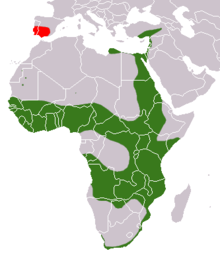
|

|
Common slender mongoose(H. sanguineus)Rüppell,1835[6] | LC[15]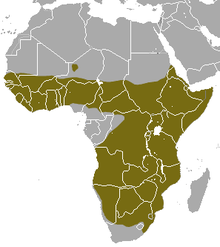
|
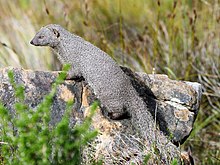
|
Cape gray mongoose(H. pulverulentus)(Wagner,1839)[16] | LC[17]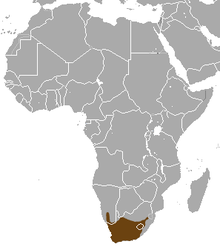
|

|
Somalian slender mongoose(H. ochraceus)Gray,1848[18] | LC[19]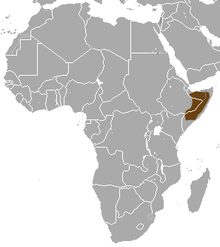
|
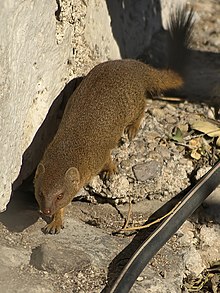
|
Angolan slender mongoose(H. flavescens)(Bocage,1889)[20] | LC[21]
|
References[edit]
- ^abWozencraft, W. C.(2005)."GenusHerpestes".InWilson, D. E.;Reeder, D. M. (eds.).Mammal Species of the World: A Taxonomic and Geographic Reference(3rd ed.). Johns Hopkins University Press. p. 567–570.ISBN978-0-8018-8221-0.OCLC62265494.
- ^Taylor, M.E. & Matheson, J. (1999). "A craniometric comparison of the African and Asian mongooses in the genusHerpestes(Carnivora: Herpestidae) ".Mammalia.63(4): 449–464.doi:10.1515/mamm.1999.63.4.449.S2CID84384697.
- ^Veron, G.; Colyn, M.; Dunham, A. E.; Taylor, P. & Gaubert, P. (2004)."Molecular systematics and origin of sociality in mongooses (Herpestidae, Carnivora)"(PDF).Molecular Phylogenetics and Evolution.30(3): 582–598.doi:10.1016/S1055-7903(03)00229-X.PMID15012940.
- ^Fredga, K. (1977). "Chromosomal Changes in Vertebrate Evolution".Proceedings of the Royal Society of London.Series B, Biological Sciences.199(1136): 377–397.doi:10.1098/rspb.1977.0148.JSTOR77302.PMID22865.S2CID32364326.
- ^Illiger, C. (1815)."Überblick der Säugethiere nach ihrer Verteilung über die Welttheile"[Overview of mammals according to their distribution across the World].Abhandlungen der physikalischen Klasse der Königlich-Preußischen Akademie der Wissenschaften.1804−1811: 39−159.
- ^abRüppell, E. (1835)."Herpestes. Illiger".Neue Wirbelthiere zu der Fauna von Abyssinien gehörig[New vertebrates belonging to the Fauna of Abyssinia] (in German). Frankfurt am Main: S. Schmerber. pp. 27–32.
- ^Gray, J.E. (1864)."A revision of the genera and species of Viverrine animals (Viverridae) founded on the collection in the British Museum".Proceedings of the Zoological Society of London(November): 502–579.
- ^Thomas, O. (1882)."On the African Mungooses".Proceedings of the Zoological Society of London(January): 59–93.
- ^Mivart, St. G. J. (1882)."On the Classification and Distribution of the Aeluroidea".Proceedings of the Zoological Society of London(February): 135–270.
- ^Pomel, A. (1853)."Herpestes.Illig. ".Catalogue méthodique et descriptif des vertébrés fossiles découverts dans le bassin hydrographique de la Loire.Paris: Baillière. pp. 64–66.
- ^Lydekker, R. (1887)."Herpestes lemanensis,Pomel ".Catalogue of the fossil Mammalia in the British museum, (Natural History).Vol. 5, Supplement. London: British Museum (Natural History). p. 317.
- ^Patou, M.; Mclenachan, P.A.; Morley, C.G.; Couloux, A.; Jennings, A.P.; Veron, G. (2009)."Molecular phylogeny of the Herpestidae (Mammalia, Carnivora) with a special emphasis on the AsianHerpestes".Molecular Phylogenetics and Evolution.53(1): 69–80.doi:10.1016/j.ympev.2009.05.038.PMID19520178.
- ^Linnaeus, C. (1758)."Viverra ichneumon".Caroli Linnæi Systema naturæ per regna tria naturæ, secundum classes, ordines, genera, species, cum characteribus, differentiis, synonymis, locis(in Latin). Vol. Tomus I (decima, reformata ed.). Holmiae: Laurentius Salvius. p. 41.
- ^Do Linh San, E.; Maddock, A.H.; Gaubert, P. & Palomares, F. (2016)."Herpestes ichneumon".IUCN Red List of Threatened Species.2016:e.T41613A45207211.
- ^Do Linh San, E. & Maddock, A.H. (2016)."Herpestes sanguineus".IUCN Red List of Threatened Species.2016:e.T41606A45206143.
- ^Wagner, J.A. (1839)."Über die Verwandtschafts-Verhältnisse der Pharaonsratte".Gelehrte Anzeigen der Königlich Bayerischen Akademie der Wissenschaften zu München.9(183): 425–429.
- ^Do Linh San, E. & Cavallini, P. (2015)."Herpestes pulverulentus".IUCN Red List of Threatened Species.2015:e.T41600A45205999.
- ^Gray, J.E. (1848)."Description of a new species ofHerpestes,from Abyssinia ".Proceedings of the Zoological Society of London(November): 138–139.
- ^Taylor, M.E. & Do Linh San, E. (2015)."Herpestes ochraceus".IUCN Red List of Threatened Species.2015:e.T41605A86159385.
- ^Bocage, J.V.B. (1889)."Mammifère d'Angola et du Congo".Jornal de Sciencias mathematicas, physicas e naturaes.2.1:174–185.
- ^Rapson, S. & Rathbun, G.B. (2015)."Herpestes flavescens".IUCN Red List of Threatened Species.2015:e.T41599A45205933.Retrieved15 December2021.
